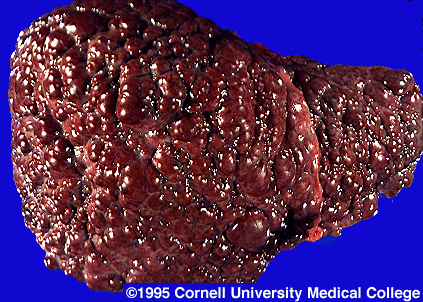
Hepatitis B:
Patient Education
This page provides information for people curious about basic characteristics of Hepatitis B and the disease it causes. It is intended for an audience without a scientific background; for more in-depth information on Hepatitis B biology, current research in Hepatitis B, and more links for even more information about Hepatitis B, explore the links on the sidebar. Enjoy!

What is Hepatitis B?
Hepatitis B virus (HBV) is a virus that is transmitted sexually, in contaminated blood, and from mother to child. HBV can cause serious health problems, although many treatment options do exist. Hepatitis B infection is the 10th leading cause of death in the world, affecting approximately 2 billion people across the globe. The most serious complication of HBV infection is liver cancer (hepatocellular carcinoma), which alone causes more than 300,000 deaths per year. The risk of developing liver cancer after being infected with HBV is low, occurring in 1-4% of patients with HBV infections. Other serious complications that can arise from HBV infection are cirrhosis or scarring of the liver and a rare immunological disorder called immune complex disease. Cirrhosis (scarring of the liver) is also a serious health problem associated with HBV.

Here are some basic characteristics about Hepatitis B infection:
|
Incubation period |
60-90 days* |
|
Fatality rate |
1% |
|
Recovery Rate |
90% |
|
Rate of Chronic Infection |
<10%** |
*with a range of 45-120 days
**although this can approach 90% in babies infected with HBV at birth
Is there a vaccine for Hepatitis B?
Yes. The first vaccine for Hepatitis B was launched in 1981. Since then a recombinant vaccine has been developed, which is cheaper and effective. The current vaccine contains altered viral proteins, which induce the immune system to launch an antibody response as if the real virus were in the body. The viral proteins are inserted into yeast bacteria, which then produce protein in mass quantities before it is purified to make the vaccine. The vaccine is given in 3 doses over a 6-month period as part of the universal childhood vaccination schedule recommended by the American Academy of Pediatricians.
Who should get the vaccine?

Everyone! All children should be given the vaccine as part of their routine childhood immunizations. In addition, people in high risk groups (healthcare workers, IV drug users, sexually active individuals, and certain ethnicities such as native Alaskans) should be vaccinated as a precaution. The vaccine can also confer some resistance if given after exposure to HBV.
What treatment options exist for Hepatitis B?
Alpha interferon and lamivudine are two drugs used to treat HBV acute infection and manage chronic HBV infection. For more information, see the Treatment link on sidebar.
What are symptoms of Hepatitis B infection?
Initial or primary infection may not cause any significant symptoms, especially in younger children. However, fatigue, loss of appetite (anorexia) and malaise may be experienced. Because liver function is impaired by HBV, jaundice is a common symptom (affecting over 50% of adults with clinically significant disease). In addition, vomiting and occasionally arthritis or a rash can be caused by HBV infection.
What does “chronic infection” mean?
People who have chronic Hepatitis B infection never fully recover from infection. Instead, they remain carriers of the virus and continue to shed the virus in their body fluids. About 1 million Americans are chronically infected with HBV (<10% of people who contract HBV). The age of HBV infection influences the risk of becoming chronically infected; whereas only 10% of adults become carriers, almost 90% of children infected with HBV develop chronic infections.Chronic carriers are at significantly higher risk of liver cancer; approximately 25% of people with chronic HBV infections eventually die from liver cancer and/or cirrhosis.
What can I do to prevent getting Hepatitis B?
Above all, get vaccinated. Beyond that, avoiding risky behaviors is the best way to avoid contracting HBV and is always a good idea for promoting health. Use condoms during sexual intercourse, never share needles, razors, nail clippers or earrings, and avoid taking street drugs. Post exposure vaccination measures can be effective, especially if combined with administration of human antibodies or immunoglobulins.
More Statistics Resources:
National Center for Health Statistics’ Viral Hepatitis webpage: http://www.cdc.gov/nchs/fastats/hepatits.htm
More Patient Resources:
American Association for the Study of Liver Diseases: www.aasld.org
American Liver Foundation: www.liverfoundation.org
Centers for Disease Control and Prevention Hepatitis B webpage: http://www.cdc.gov/ncidod/diseases/hepatitis/b/
Hepatitis B Foundation: www.hepb.org
HIV and Hepatitis.com: www.hivandhepatitis.com
National Digestive Diseases Information Clearinghouse: “What I Need to Know About Hepatitis B” http://digestive.niddk.nih.gov/ddiseases/pubs/hepb_ez/index.htm
U.S. National Library of Medicine Hepatitis B webpage: http://www.nlm.nih.gov/medlineplus/hepatitisb.html
Sources:
CDC Hepatitis B Website: http://www.cdc.gov/ncidod/diseases/hepatitis/b/faqb.htm
Dimmock, N.J., Easton, A.J., and Leppard, K.N. Introduction to Modern Virology. Blackwell Publishing, Oxford: © 2001.
Strauss, James and Ellen. Viruses and Human Disease. Academic Press, San Francisco: © 2002.
Pictures courtesy of:
http://www.younggay.de/thema/gesundheit/hepatitis/hepatitis-b-virus.jpg; http://edcenter.med.cornell.edu/CUMC_PathNotes/Liver,GB,Pancreas/1519.gif;
http://www.cnn.com/HEALTH/9712/08/liver.cancer.vaccine/vaccine.jpg